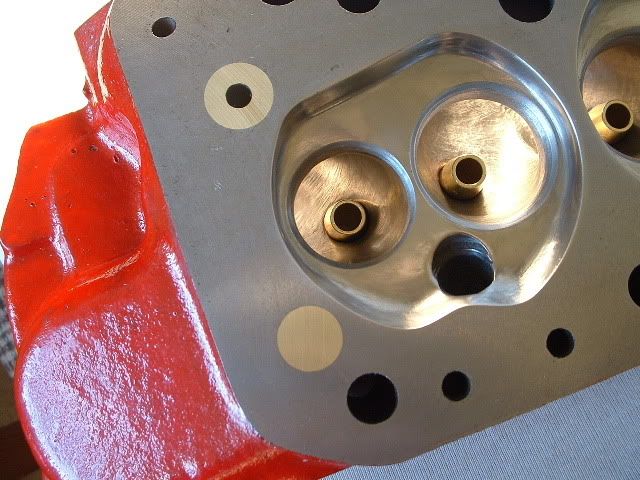| Page: |
| Home > Help Needed / General Tech Chat > 20832 vs 20831 pistons. | |||||||
 (2)[/url] by [url=https://www.flickr.com/photos/150672766@N03/]Rod Sugden[/url], on Fli) 5988 Posts Member #: 2024 Formally Retired Rural Suffolk |
26th Feb, 2017 at 01:34:17pm
From what I've read on the forum after a lot of searching they both seem to be solid skirt but 20832 "early" MG Metro N/A and 20831 the turbo version and the only difference I see noted is the size of the dish (turbo slightly larger).
Schrödinger's cat - so which one am I ??? |
||||||
|
Forum Mod 10979 Posts Member #: 17 ***16*** SouthPark, Colorado |
26th Feb, 2017 at 01:59:59pm
The turbo crank is CAM6581 and is used to be easily identifiable as not being as worn out as they were superior (in metallurgical ways we never really ever figured out - lol) to the factory crank.
On 17th Nov, 2014 Tom Fenton said:
Sorry to say My Herpes are no better Ready to feel Ancient ??? This is 26 years old as of 2022 https://youtu.be/YQQokcoOzeY |
||||||
|
1909 Posts Member #: 9764 Post Whore Northamptonshire. |
26th Feb, 2017 at 04:45:50pm
I was told it's only the 500 odd metro challenge cars that had the special crank the rest where just standard a plus cranks
On 26th Feb, 2017 TurboDave16V said:
The turbo crank is CAM6581 and is used to be easily identifiable as not being as worn out as they were superior (in metallurgical ways we never really ever figured out - lol) to the factory crank. I believe they were machines exactly the same as the standard A+ crank... |
||||||
 4619 Posts Member #: 20 My sister is so fit I won't show anyone her picture Lake District |
26th Feb, 2017 at 06:01:00pm
The 6581 cranks seem to have been limited to early Metros. Both the ones I have coming from C reg models. I never found one from any later engines.
|
||||||
 (2)[/url] by [url=https://www.flickr.com/photos/150672766@N03/]Rod Sugden[/url], on Fli) 5988 Posts Member #: 2024 Formally Retired Rural Suffolk |
26th Feb, 2017 at 06:36:13pm
Thanks all,
Schrödinger's cat - so which one am I ??? |
||||||
 4619 Posts Member #: 20 My sister is so fit I won't show anyone her picture Lake District |
26th Feb, 2017 at 06:47:18pm
Iirc Isn't the difference in the oil control ring ?
|
||||||
|
Forum Mod 10979 Posts Member #: 17 ***16*** SouthPark, Colorado |
26th Feb, 2017 at 07:04:42pm
6232 is indeed the stock A+ crank.
Edited by TurboDave16V on 26th Feb, 2017. On 17th Nov, 2014 Tom Fenton said:
Sorry to say My Herpes are no better Ready to feel Ancient ??? This is 26 years old as of 2022 https://youtu.be/YQQokcoOzeY |
||||||
|
Forum Mod 10979 Posts Member #: 17 ***16*** SouthPark, Colorado |
26th Feb, 2017 at 07:06:10pm
The turbo and non turbo rings are indeed different; I thought the turbo ones were thicker. It's been so long since I've seen one, I just don't remember... On 17th Nov, 2014 Tom Fenton said:
Sorry to say My Herpes are no better Ready to feel Ancient ??? This is 26 years old as of 2022 https://youtu.be/YQQokcoOzeY |
||||||
 6743 Posts Member #: 828 Post Whore uranus |
26th Feb, 2017 at 09:25:06pm
the one in my car came from a f reg too dave . Medusa + injection = too much torque for the dyno ..https://youtu.be/qg5o0_tJxYM |
||||||
 11046 Posts Member #: 965 Post Whore Preston On The Brook |
27th Feb, 2017 at 12:00:45am
On 26th Oct, 2004 TurboDave16v said:
Is it A-Series only? I think it should be... So when some joey comes on here about how his 16v turbo vauxhall is great compared to ours, he can be given the 'bird'... On 26th Oct, 2004 Tom Fenton said:
Yep I agree with TD........ |
||||||
 (2)[/url] by [url=https://www.flickr.com/photos/150672766@N03/]Rod Sugden[/url], on Fli) 5988 Posts Member #: 2024 Formally Retired Rural Suffolk |
27th Feb, 2017 at 08:52:20am
Interesting stuff,
On 27th Feb, 2017 Sprocket said:
Early blocks had the groove/groove main bearings (excluding the turbo) and full skirt pistons. I can confirm the first bit as that is what I'm currently using but I acquired it as a bare block, no history and the serial number plate missing, so don't know what car it started life in or what pistons/crank it would have had at start of life. The WMF1024 on the block I have just acquired is right down the back above the gearbox flange and I can't see that location on the current one in the car because of all my dual wideband plumbing being down there. The only photo I have of the block in that area from when I was building it shows some raised letters/numbers but too indistinct to read. (there is no marking of that sort on the front, not that I can see with the radiator in the way). The different machining of the bearing caps for the non-grooved bottom bearing shell is obvious. On 27th Feb, 2017 Sprocket said: That is what my thoughts were, hence the question. I've read many times that the oil control ring is wider on the turbo piston compared to a "standard" piston but did not know if the 20832 counted as "standard".
I'm sure the rings are the same, the pistons differ only by the cc in the dish and the compression height. For some reason AR decided the MG would have a 6cc piston but run the piston down the bore a little, where as the turbo piston had 12cc dish and was nearly flush with the deck. Both pistons look identical in all other respects. The ring groove measures 4mm by simple vernier (anyone know what the 20831 turbo groove width is ??? ) and the ring is quite an unusual 4 piece arrangement. Well, unusual to me, I'm used to two very thin rings with a wave spring between but this has two wave springs, one on top of the other in the groove, one coarse, one fine. Anyway, thanks for all your help. I'm beginning to wonder if I should have been more careful getting these out (the rings are all OK but I damaged one of the pistons in my attempts to protect the bores, this block too looked as if it has been stored with the No4 end in a pond....). Schrödinger's cat - so which one am I ??? |
||||||
| Home > Help Needed / General Tech Chat > 20832 vs 20831 pistons. | |||||||
|
|||||||
| Page: |
